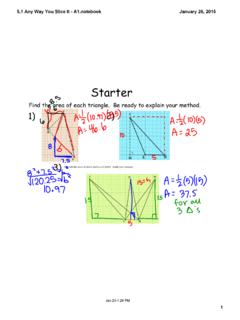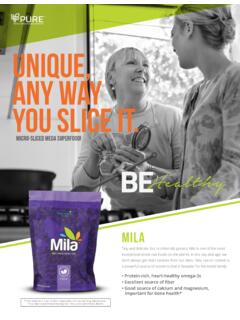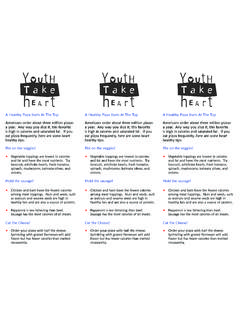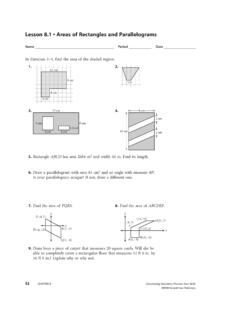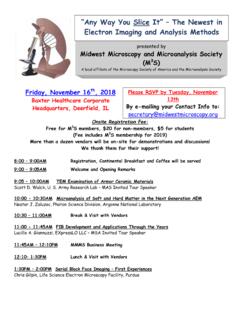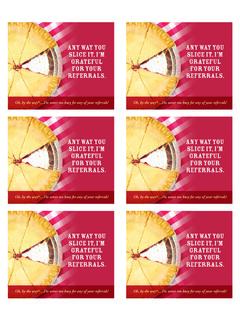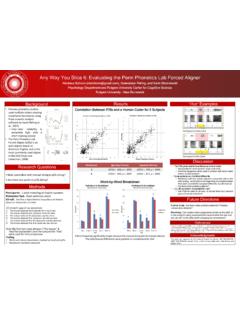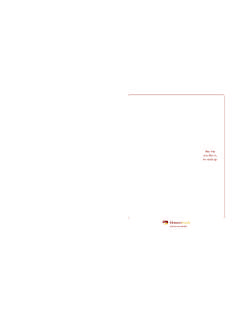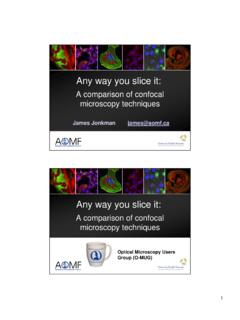Transcription of 5.1 Any Way You Slice It - uen.org
1 SECONDARY MATH III // MODULE 5 MODELING WITH GEOMETRY Mathematics Vision Project Licensed under the Creative Commons Attribution CC BY Any Way You Slice It A Develop Understanding Task Students in Mrs. Denton s class were given cubes made of clay and asked to Slice off a corner of the cube with a piece of dental floss. Jumal sliced his cube this way. Jabari sliced his cube like this. 1. Which student, Jumal or Jabari, interpreted Mrs. Denton s instructions correctly? Why do you say so? When describing three-dimensional objects such as cubes, prisms or pyramids we use precise language such as vertex, edge or face to refer to the parts of the object in order to avoid the confusion that words like corner or side might create.
2 A cross section is the face formed when a three-dimensional object is sliced by a plane. It can also be thought of as the intersection of a plane and a solid. 2. Draw and describe the cross section formed when Jumal sliced his cube. 3. Draw and describe the cross section formed when Jabari sliced his cube. 4. Draw some other possible cross-sections that can be formed when a cube is sliced by a plane. CC BY Sean Freese 1 SECONDARY MATH III // MODULE 5 MODELING WITH GEOMETRY Mathematics Vision Project Licensed under the Creative Commons Attribution CC BY 5. What type of quadrilateral is formed by the intersection of the plane that passes through diagonally opposite edges of a cube?
3 Explain how you know what quadrilateral is formed by this cross section. Cross sections can be visualized in different ways. One way is to do what Jumal and Jabari did cut a clay model of the solid with a piece of dental floss. Another way is to partially fill a clear glass or plastic model of the three-dimensional object with colored water and tilt it in various ways to see what shapes the surface of the water can assume. 2 SECONDARY MATH III // MODULE 5 MODELING WITH GEOMETRY Mathematics Vision Project Licensed under the Creative Commons Attribution CC BY Experiment with various ways of examining the cross sections of different three-dimensional shapes.
4 6. Partially fill a cylindrical jar with colored water, and tilt it in various ways. Draw the cross sections formed by the surface of the water in the jar. 7. Try to imagine a cubical jar partially filled with colored water, and tilted in various ways. Which of the following cross sections can be formed by the surface of the water? Which are impossible? a square a rhombus a rectangle a parallelogram a trapezoid a triangle a pentagon a hexagon an octagon a circle 3 SECONDARY MATH III // MODULE 5 MODELING WITH GEOMETRY Mathematics Vision Project Licensed under the Creative Commons Attribution CC BY Any Way You Slice It Teacher Notes A Develop Understanding Task Purpose: The purpose of this task is to surface a variety of strategies for visualizing two-dimensional cross sections of three-dimensional objects, and to identify and/or draw such cross sections.
5 Students encounter cross sections when they Slice a loaf of bread, a piece of cake, or a hard-boiled egg, or when they tilt a glass of water in different ways and examine the surface of the water. This task aims to formalize these observations by defining a cross section as the intersection of a plane and a three-dimensional object. Core Standards Focus: Identify the shapes of two-dimensional cross-sections of three-dimensional objects, and identify three-dimensional objects generated by rotations of two-dimensional objects. Standards for Mathematical Practice: SMP 7 Look for and make use of structure Vocabulary: Students will need to understand that a cross section is the shape of the surface formed when a geometric solid is sliced by a plane.
6 The Teaching Cycle: Launch (Whole Class): Give students a few minutes to respond to questions 1-4 individually, and then discuss them as a class. Students should note that corner is an ambiguous term, since it can refer to the vertex point where the edges of the cube meet, or to the three dimensional region where two faces of the cube meet, such as when we say, Go stand in the corner of the room. Encourage students to use more precise language as they work through this, and subsequent tasks. Question 4 should highlight the strategy of drawing in the edges on the faces of the cube where the plane intersects the faces, such as in the following diagrams.
7 SECONDARY MATH III // MODULE 5 MODELING WITH GEOMETRY Mathematics Vision Project Licensed under the Creative Commons Attribution CC BY Following this introductory discussion, set students to work on the remainder of the task. Set up some stations in the classroom where students can access the materials needed to work on questions 6 and 7. Explore (Small Group): Students can discuss question 5 in small groups while waiting for their turns to access the materials for questions 6 and 7. Students may initially think that the shaded cross section in question 5 is a parallelogram (or a rhombus), since it looks like one in this two-dimensional image.
8 Listen for students justification as to what type of quadrilateral they claim it to be. Ask how they might justify that one side length is longer than or the same length as another. How might they reason about the angles in the quadrilateral? If possible, for question 6 provide a variety of sealed containers, including a cylinder, each partially filled with colored water. It might be surprising to students to find that they can create rectangular cross sections in a cylinder, or a triangular cross section in a cone. As an alternative approach to this question, allow students to partially submerge objects in water and trace the edges where the object intersects the surface of the water.
9 Regardless of how students collect the data, they should sketch the various types of cross sections that can be formed by intersecting a particular object with a plane. In question 7 watch for students who find it difficult to visualize how to draw cross sections within a two-dimensional drawing of a three-dimensional object. How do they attend to the vertices, SECONDARY MATH III // MODULE 5 MODELING WITH GEOMETRY Mathematics Vision Project Licensed under the Creative Commons Attribution CC BY edges and faces that would be intersected by a single plane? Watch for students who create impossible cross sections by using points on the same edge or face that could not possibly lie in a single plane.
10 Discuss (Whole Class): This is an open-ended task that is intended to surface different ways of thinking about cross sections when we can t actually experiment with an object directly. Discuss the strategies that have emerged for students and relate these back to the ideas that was introduced in question 4: specifically, to imagine tracing the edges of the figure outlining the surface where the plane intersects the object. Have students draw and describe some of the cross sections they noted in various three-dimensional shapes that were unexpected or surprising to them, such as the rectangular cross sections in a cylinder or the hexagon cross section in a cube.










